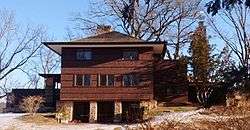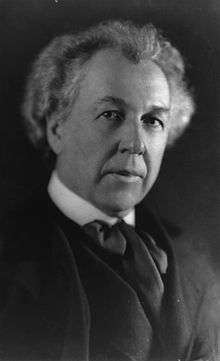Tan-y-Deri
Tan-y-Deri, is also known as the Andrew T. Porter Home and the Jane and Andrew Porter Home. Jane Porter (1869-1953) was the sister of architect Frank Lloyd Wright. The home was commissioned from Wright in 1907, with Jane and Andrew Porter (1858-1948) moving in with their children James (1901-1912) and Anna (1905-1934) by late January 1908.[1] The home stands in a valley in the town of Wyoming, Wisconsin (near the town of Spring Green). This valley was originally settled by the Lloyd Joneses, who were the family of Wright and his sister's mother.[2] The Lloyd Joneses were originally from Wales and, as a result of this heritage, Wright chose a Welsh name for the Porter home: “Tan-y-deri” is Welsh for “Under the oaks”.[3]
Tan-y-deri | |
 Tan-y-Deri (Jane and Andrew Porter home) on the Taliesin Estate | |
| Location | south of Spring Green, in Iowa County, Wisconsin |
|---|---|
| Coordinates | 43°08′30″N 90°04′15″W |
| Built | 1907-08 |
| Architect | Frank Lloyd Wright |
| Architectural style | Prairie School |
| Visitation | 25,000 (2019) |
| Website | "Tan-y-Deri". |
| NRHP reference No. | 73000081 |
| Added to NRHP | March 14, 1973 |
Tan-y-Deri is on the Taliesin estate, which was declared a National Historic Landmark in 1976. It is one of five Wright-designed buildings on the estate; two of them can be seen from it: the Romeo and Juliet Windmill, and Taliesin. The fifth building is Midway Barn, Wright's farming facility.
Design
The Porter family moved to the town of Wyoming because Andrew had been hired to be the business manager of the nearby Hillside Home School run by Jane's aunts, Jane and Ellen C. Lloyd Jones.[4] Wright designed a home for the Porters, but they chose a design of his that was more economical: Tan-y-deri is an example of one of his designs for A Fireproof House for $5,000. Wright's intended to make these homes fireproof by using concrete. However, since the home was intended for the country, the architect modified the design so that it was clad with cedar shingles.
The home was designed with two floors. The main floor had the living room, dining room, and kitchen. And open veranda was accessible from the living room and dining room. The second floor had four bedrooms and the bathroom. Each bedroom was placed on a corner. The home design included an unattached horse stable (no longer extant).
History
In 1911, Wright would design his own home, Taliesin, down from the top of a hill within sight of Tan-y-deri (Taliesin is also Welsh word and means, "shining brow"). Three years later, Tan-y-deri would be used for triage following the attack and fire at Taliesin that resulted in seven deaths. Jane and Andrew's four-year-old son, Franklin, was kept upstairs away from the victims, but his bedroom overlooked the open veranda on which they were laid. Wright biographer, Meryle Secrest, wrote that Franklin, while recalling his memories of the event:
… Mingled with the memory of intense excitement of the fire is that of men moaning in the night with pain, and of a whippoorwill singing during moments of quiet…. For ever after the song of a whippoorwill at night at Tan-y-Deri seems infinitely sad.[5]
The Hillside Home School closed in 1915, so the next year, Andrew went to work in Chicago in an investment firm. Two years after that, the family followed Andrew to Chicago and the Porters purchased the Arthur Heurtley House, also by Wright. Tan-y-deri then became a summer vacation home for the Porters until the 1930s.[6] Andrew Porter retired in 1935, after which he and Jane returned to living at Tan-y-deri full time. They remodeled the lower level, opening the former basement into excavated space on the north.[7] By the 1930s, Frank Lloyd Wright had started the Taliesin Fellowship (his architectural apprentice program) on the Taliesin estate.
Andrew died several years after World War II, in 1948. Jane died five years later.[8] In 1955 their son, Franklin, sold the home and surrounding acre to his uncle, so it also became part of the Taliesin estate. The estate is owned by the Frank Lloyd Wright Foundation, which was founded by Frank Lloyd Wright and his wife, Olgivanna, in 1940.
Frank Lloyd Wright left Tan-y-Deri and the rest of the Taliesin estate to the Frank Lloyd Wright Foundation. Because the house has been owned by the Frank Lloyd Wright Foundation, it has since been used as housing by the Taliesin Fellowship and the School of Architecture at Taliesin.[9] A major restoration project of the home was carried out by Taliesin Preservation,[10] an independent non-profit organization dedicated to preserving the Taliesin estate and running a tour program and bookstore housed near the site at the Frank Lloyd Wright Visitor Center (also a Wright design).[11]
References
- January 23, 1908 edition of The Weekly Home News, the newspaper of nearby Spring Green, states that the Porters had just settled into their new home.
- Maginel Wright Barney, The Valley of the God-Almighty Joneses: Reminiscences of Frank Lloyd Wright’s Sister (1965 Appleton-Century; 1st edition; Unity Chapel Publications, 1986) ISBN 978-1125132081
- William Allin Storrer, The Frank Lloyd Wright Companion (University of Chicago Press, 2006), ISBN 978-0226776217, p. 133.
- Mary Jane Hamilton, "Tan-y-deri: Another View of Taliesin’s Unfolding Narrative,” in The Frank Lloyd Wright Quarterly, Summer 2006 (Vol. 17, No. 3), p. 11.
- Meryle Secrest, Frank Lloyd Wright: A Biography (University of Chicago Press, 1998), ISBN 978-0226744148, p. 222.
- Hamilton, p. 17-18.
- Hamilton, p. 18.
- Hamilton, p. 19
- http://taliesin.edu/
- http://www.taliesinpreservation.org/learn/history
- http://www.taliesinpreservation.org/
See Also
- Maginel Wright Barney, The Valley of the God-Almighty Joneses: Reminiscences of Frank Lloyd Wright’s Sister. 1965 Appleton-Century; 1st edition; Unity Chapel Publications, 1986. ISBN 978-1125132081.
- Bruce Brooks Pfeiffer, Frank Lloyd Wright Complete Works Taschen, 2009.
- Meryle Secrest, Frank Lloyd Wright: A Biography (University of Chicago Press, 1998). ISBN 978-0226744148.
- William Allin Storrer, The Frank Lloyd Wright Companion. University of Chicago Press, 2006, ISBN 978-0226776217 (S.134).

